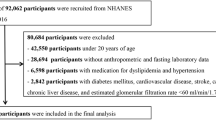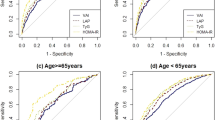Abstract
BACKGROUND/OBJECTIVES:
Lipid accumulation product (LAP) is an index, which combines waist circumference (WC) and triglyceride (TG) reflecting lipid accumulation. The aims of the study were to explore the relationship between LAP and insulin resistance (IR) and to assess whether LAP was superior to WC and body mass index (BMI) in identifying IR.
SUBJECTS/METHODS:
The study was cross-sectional and included 2524 non-diabetic subjects from China. The blood pressure (BP), anthropometric measurements, glucose levels, insulin levels and a fasting lipid profile were measured. BMI, the homeostasis model assessment of IR (HOMA-IR) and LAP were calculated.
RESULTS:
In both sexes, BP, BMI, total cholesterol (TC), non high-density lipoprotein cholesterol (non-HDL-C), HOMA-IR, fasting and postprandial glucose levels increased across LAP quartiles (P<0.001), while HDL cholesterol (HDL-C) levels decreased across LAP quartiles (P<0.001). Pearson’s correlation analysis demonstrated that HOMA-IR was correlated with LAP, BMI, WC, TG, HDL-C and non-HDL-C in both sexes (P<0.001). Multivariate analysis demonstrated that LAP had a greater impact on HOMA-IR than BMI and WC.
CONCLUSIONS:
LAP is closely associated with HOMA-IR and is a powerful index that outperforms BMI and WC in identifying IR in non-diabetic individuals.
This is a preview of subscription content, access via your institution
Access options
Subscribe to this journal
Receive 12 print issues and online access
$259.00 per year
only $21.58 per issue
Buy this article
- Purchase on Springer Link
- Instant access to full article PDF
Prices may be subject to local taxes which are calculated during checkout
Similar content being viewed by others
References
Kriketos AD, Furler SM, Gan SK, Poynten AM, Chisholm DJ, Campbell LV . Multiple indexes of lipid availability are independently related to whole body insulin action in healthy humans. J Clin Endocrinol Metab 2003; 88: 793–798.
Després JP, Lemieux I, Bergeron J, Pibarot P, Mathieu P, Larose E et al. Abdominal obesity and the metabolic syndrome: contribution to global cardiometabolic risk. Arterioscler Thromb Vasc Biol 2008; 28: 1039–1049.
Boden G . Obesity and free fatty acids. Endocrinol Metab Clin Norht Am 2008; 37: 635–646.
Bergman RN, Kim SP, Hsu IR, Catalano KJ, Chiu JD, Kabir M et al. Abdominal obesity: role in the pathophysiology of metabolic disease and cardiovascular risk. Am J Med 2007; 120 (2 Suppl.1), S3–S8.
Scaglione R, Di Chiara T, Cariello T, Licata G . Visceral obesity and metabolic syndrome: two faces of the same medal? Intern Emerg Med 2010; 5: 111–119.
Lewanczuk RZ, Paty BW, Toth EL . Comparison of the [13C] glucose breath test to the hyperinsulinemic–euglycemic clampwhen determining insulin resistance. Diabetes Care 2004; 27: 441–447.
Matthews DR, Hosker JP, Rudenski AS, Naylor BA, Treacher DF, Turner RC . Homeostasis model assessment: insulin resistance and beta-cell function from fasting plasma glucose and insulin concentrations in man. Diabetologia 1985; 28: 412–419.
Bozorgmanesh M, Hadaegh F, Azizi F . Diabetes prediction, lipid accumulation product, and adiposity measures; 6-year follow-up: Tehran lipid and glucose study. Lipids Health Dis 2010; 9: 45.
Kawamoto R, Tabara Y, Kohara K, Miki T, Kusunoki T, Takayma S et al. Relationships between lipid profiles and metabolic syndrome, insulin resistance and serum high molecular adiponectin in Japanese community-dwelling adults. Lipids Health Dis 2011; 10: 79.
Alberti KG, Eckel RH, Grundy SM, Zimmet PZ, Cleeman JI, Donato KA et al. Harmonizing the metabolic syndrome: a joint interim statement of the International Diabetes Federation Task Force on Epidemiology and Prevention; National Heart, Lung, and Blood Institute; American Heart Association; World Heart Federation; International Atherosclerosis Society; and International Association for the Study of Obesity. Circulation 2009; 120: 1640–1645.
Nieves DJ, Cnop M, Retzlaff B, Walden CE, Brunzell JD et al. The atherogenic lipoprotein profile associated with obesity and insulin resistance is largely attributable to intra-abdominal fat. Diabetes 2003; 52: 172–179.
Kahn HS . The ‘lipid accumulation product’ performs better than the body mass index for recognizing cardiovascular risk: a population-based comparison. BMC Cardiovasc Disord 2005; 5: 26.
Wiltgen D, Benedetto IG, Mastella LS, Spirtzer PM . Lipid accumulation product index: a reliable marker of cardiovascular risk in polycystic ovary syndrome. Hum Reprod 2009; 24: 1726–1731.
Taverna MJ, Martinez-Larrad MT, Frechtel GD, Serrano-Rios M . Lipid accumulation product: a powerful marker of metabolic syndrome in healthy population. Eur J Endocrinol 2011; 164: 559–567.
Ran XW, Li XS, Tong NW, Li QF, Tang BD, Li JX . Body fat distribution: its characteristic and relationship to cardiovascular risk factors in obese Chinese. J Sichuan Univ (Med Sci Edi) 2004; 35: 699–703. (in Chinese).
Bressler P, Bailey S, Matsuda M, DeFronzo RA . Insulin resistance and coronary artery disease. Diabetologia 1996; 39: 1345–1350.
Choi SH, Ginsberg HN . Increased very low density lipoprotein (VLDL) secretion, hepatic steatosis, and insulin resistance. Trends Endocrinol Metab 2011; 22: 353–363.
Sam S, Haffner S, Davidson MH, D′Agostino RB, Feinstein S, Kondos G et al. Hypertriglyceridemic waist phenotype predicts increased visceral fat in subjects with type 2 diabetes. Diabetes Care 2009; 32: 1916–1920.
Lemieux I, Pascot A, Couillard C, Lamarche B, Tchernof A, Alméras N et al. Hypertriglyceridemic waist: A marker of the atherogenic metabolic triad (hyperinsulinemia; hyperapolipoprotein B; small, dense LDL) in men? Circulation 2000; 102: 179–184.
St-Pierre J, Lemieux I, Vohl M, Perron P, Tremblay G, Despres J et al. Contribution of abdominal obesity and hypertriglyceridemia to impaired fasting glucose and coronary artery disease. Am J Cardio 2002; l90: 15–18.
Gu D, Reynolds K, Wu X, Chen J, Duan X, Reynold RF et al. Prevalence of the metabolic syndrome and overweight among adults in China. Lancet 2005; 365: 1398–1405.
Gu D, Reynolds K, Yang W, Chenn Wu X, Duan X et al. The prevalence of metabolic syndrome in the general adult population aged 35–74 years in China. Chin J Diabetes 2005; 13: 181–186.
Després JP, Cartier A, Côté M, Arsenault BJ . The concept of cardiometabolic risk: Bridging the fields of diabetology and cardiology. Ann Med 2008; 40: 514–523.
Kraegen EW, Cooney GJ, Ye J . Thompson. Triglycerides, fatty acids and insulin resistance—hyperinsulinemia. Exp Clin Endocrinol Diabetes 2001; 109: S516–S526.
Kim JK, Fillmore JJ, Chen Y, Yu C, Moore IK, Pypaert M et al. Tissue-specific overexpression of lipoprotein lipase causes tissue-specific insulin resistance. Proc Natl Acad Sci USA 2001; 98: 7522–7527.
Kahn HS . The lipid accumulation product is better than BMI for identifying diabetes. Diabetes Care 2006; 29: 151–153.
Acknowledgements
This research was supported by Natural Science Foundation Project of Chongqing CSTC(No.2009BB5076).
Author information
Authors and Affiliations
Corresponding author
Ethics declarations
Competing interests
The authors declare no conflict of interest.
Rights and permissions
About this article
Cite this article
Xia, C., Li, R., Zhang, S. et al. Lipid accumulation product is a powerful index for recognizing insulin resistance in non-diabetic individuals. Eur J Clin Nutr 66, 1035–1038 (2012). https://doi.org/10.1038/ejcn.2012.83
Received:
Revised:
Accepted:
Published:
Issue Date:
DOI: https://doi.org/10.1038/ejcn.2012.83
Keywords
This article is cited by
-
Impacts of a 12-week aerobic, resistance, and combined exercise training on serum FAM19A5, glucose homeostasis, and novel cardiovascular risk factors among adults with obesity
International Journal of Diabetes in Developing Countries (2024)
-
The association of meal-specific food-based dietary inflammatory index with cardiovascular risk factors and inflammation in a sample of Iranian adults
BMC Endocrine Disorders (2023)
-
Lipid accumulation product (LAP) index for the diagnosis of nonalcoholic fatty liver disease (NAFLD): a systematic review and meta-analysis
Lipids in Health and Disease (2023)
-
No association between dietary magnesium intake and body composition among Iranian adults: a cross-sectional study
BMC Nutrition (2022)
-
Relationship between lipid accumulation product and oxidative biomarkers by gender in adults from Yucatan, Mexico
Scientific Reports (2022)



